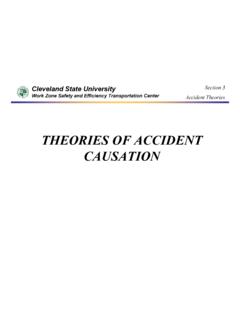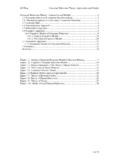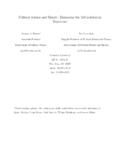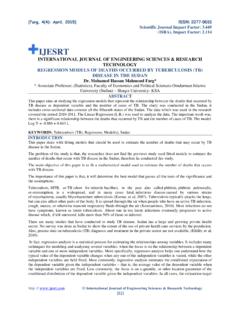Transcription of Deliverable 5.9 - Review of Accident causation …
1 Project co-financed by the European Commission Directorate General for Mobility and Transport Road Safety Data, Collection, Transfer and Analysis Deliverable - Review of Accident causation models used in Road Accident Research Please refer to this report as follows: Hermitte, T (21/09/2012) Title, Review of Accident causation models used in Road Accident Research of the EC FP7 project DaCoTA. Grant agreement No TREN / FP7 / TR / 233659 /"DaCoTA" Theme: Sustainable Surface Transport: Collaborative project Project Coordinator: Professor Pete Thomas, Vehicle Safety Research Centre, ESRI Loughborough University, Ashby Road, Loughborough, LE11 3TU, UK Project Start date: 01/01/2010 Duration 36 months Organisation name of lead contractor for this Deliverable : GIE RE PSA RENAULT Report Author(s): HERMITTE Thierry (GIE RE PR) Due date of Deliverable 31/01/2012 Submission date: 21/09/2012 Project co-funded by the European Commission within the Seventh Framework Programme Dissemination Level (delete as appropriate) PU Public TABLE OF CONTENTS Executive summary.
2 3 1. Summary .. 6 2. Introduction .. 7 3. Accidents and causes .. 9 Why do we need to understand accidents? .. 9 What is a cause? .. 10 The need for Accident causation models .. 12 The systemic approach .. 13 4. The description and analysis of the Accident causation models .. 16 The ontological point of view: the components of the DVE system and their interactions .. 16 The DVE model .. 16 The haddon matrix .. 18 The Teleological point of view: purposes and motivations .. 20 The functional point of view: the DVE system processes .. 20 The HFF model .. 20 The ACASS model .. 24 The transformational point of view: the sequence of events .. 27 The sequential 27 The OTS and VALT models .. 30 The domino theory .. 31 The DREAM model .. 33 5. Conclusion .. 38 6. References .. 40 Accident causation models report DaCoTA - WP5 - D5 9 3 EXECUTIVE SUMMARY This report allows us to make the link between WP5 and WP2.
3 Several models of Accident causation exist in road Accident research. The objective of this report is to make an inventory of these models and to identify their basis of formulation. This report is based upon a Review of literature and/or previous projects such as the models developed within SafetyNet and TRACE. A lot is known about accidentology since researchers have been working in this area for several decades, both in the areas of Accident causation and in passive safety. The basic method applied in accidentology (and especially in micro accidentology) is that the Accident is studied in its chronology: The driving phase, which is, forthe driver, a normal situation with no unexpected demands upon him. The rupture phase, that occurs when an unexpected event (or so-called precipitating event) turns the driving situation into an Accident situation for which, suddenly, the demand to the driver exceeds his normal or acceptable ability to respond.
4 The emergency phase, which covers the space and time between rupture and collision. And finally, the crash phase ( impact, collision or roll over). There are also many ways to analyse accidents and Accident mechanisms. For example, LAB (F) developed its own Accident analysis model in order to understand the production of the accidental situation. This model was inspired by previous work and especially those carried out by INRETS (F) at the beginning of the nineteen eighties in the south of France and identifies: The sequential description of the Accident circumstances, The events that could have contributed to convert a driving situation into an Accident situation, The nature of the driver functional failure ( perception, comprehension, decision, action) and the mechanism of the human failure ( driving errors, unavailability of information, under-activation to driving), An identification of manoeuvres carried out by the drivers and the trajectories of the vehicles.
5 And finally the sequential correspondence between car kinematics parameters and human cognitive parameters, from the initial conflict situation to the impact. This is the final step of the Accident analysis: its reconstruction. The use of such a model has already produced interesting results. For example, INRETS has examined French in-depth Accident data and has proposed to set a classification of accidents based on the production of human failure. The fundamental idea of this approach is to consider the human error not as a cause of the Accident but rather as a consequence of malfunctions occurring in the interactions between the driver and his environment. Some causes of the error are considered to be internal to the driver whereas other causes are considered to be external.
6 In this research, the error is exclusively studied, just before the Accident situation, from the driver perspective. It could actually be argued that part of the cause of an Accident could be nested within the organisation of traffic, production of Accident causation models report DaCoTA - WP5 - D5 9 4 vehicles, individual proneness to be involved in accidents, economical context, urban management, or other complex multi-factorial factors. This report makes an inventory of existing Accident causation models published in scientific literatures. Accident causation models report DaCoTA - WP5 - D5 9 5 Accident causation models report DaCoTA - WP5 - D5 9 6 1. SUMMARY Executive summary .. 3 1. Summary .. 6 2. Introduction .. 7 3. Accidents and causes .. 9 Why do we need to understand accidents? .. 9 What is a cause?
7 10 The need for Accident causation models .. 12 The systemic approach .. 13 4. The description and analysis of the Accident causation models .. 16 The ontological point of view: the components of the DVE system and their interactions .. 16 The DVE model .. 16 The haddon matrix .. 18 The Teleological point of view: purposes and motivations .. 20 The functional point of view: the DVE system processes .. 20 The HFF model .. 20 The ACASS model .. 24 The transformational point of view: the sequence of events .. 27 The sequential 27 The OTS and VALT models .. 30 The domino theory .. 31 The DREAM model .. 33 5. Conclusion .. 38 6. References .. 40 Accident causation models report DaCoTA - WP5 - D5 9 7 2. INTRODUCTION Traffic crashes have a major impact to European society, in 2008 over 38,000 road users died and over million were injured.
8 The economic cost is immense and has been estimated at over 160 billion for the EU 15 alone. The European Commission and National Governments place a high priority on reducing casualty numbers and have a series introduced targets and objectives. The experience of the best-performing countries is that the most effective policies are based on an evidence-bashed, scientific approach. Information about the magnitude, nature and context of the crashes is essential while detailed analyses of the role of infrastructure, vehicles and road users enables new policies to be developed. The EU funded SafetyNet project established the European Road Safety Observatory to bring together data and knowledge to support safety policy-making. The project developed the framework of the Observatory and the protocols for the data and knowledge, the ERSO is now a part of the DG-Move website The DaCoTA project will add to the strength and wealth of information in the Observatory by enhancing the existing data and adding new road safety information.
9 The main areas of work include Developing the link between the evidence base and new road safety policies Establishing a Pan-European Accident Investigation Network Bringing a wide variety of data together for users to manipulate Predicting Accident trends, presenting data to policy makers Intelligent safety system evaluation Naturalistic driving observations In this paper, we report on research activities deriving from WP5 Safety and eSafety. WP5 Safety and eSafety description Indeed, new intelligent technologies are rapidly being deployed into the transport system with the intention of reducing casualties and improving transport efficiency. Examples include driver information and hazard alert systems as well as autonomous systems that modify vehicle dynamics. The pace of development means that it is difficult to measure casualty reduction or to identify any confounding factors that may reduce system effectiveness.
10 Particular areas concern the introduction of driver distractions, inappropriate system functionality and driver awareness of the limitations of the new systems. The DaCoTA project will establish a consistent approach to the evaluation of such systems once they have been introduced to the market by specifying analytic approaches and new data needs. Accident causation models report DaCoTA - WP5 - D5 9 8 DaCoTA aims to address the specific data and analysis needs when evaluating the contribution to safety of new technologies, whether vehicle or road based. The project will develop procedures to identify and update the system functionality in terms of Accident risk prevention and injury risk prevention and to identify and update how current technology can address these needs.






